Make green shamrock-shaped macarons for St. Patrick's Day. These festive macarons are filled with a Baileys Irish cream ganache.

Want To Save This Article?
Enter your email below and we'll send it straight to your inbox. Plus, you'll receive new weekly recipe inspiration.
If you're looking for some cute and festive macarons to celebrate St. Patty's Day, this is the perfect recipe.
I'll show you to how make green clover macarons with a classic French macaron batter. Then, fill the shells with a delicious and boozy Baileys Irish cream ganache.
If you need more help with making macarons, check out my step-by-step course, for guidance along every step of the way.
Jump to:
What You'll Learn In This Recipe
- How to make shamrock shaped macaron shells with a Baileys Irish cream ganache filling.
- The most important steps to get correct in order to bake perfect macarons.
- Troubleshooting steps to try if your macarons aren't turning out correctly.
Enjoy learning tips about making macaron shells? Sign up for my free macaron template and email series. You'll learn my favorite tricks for achieving perfect macarons.
Ingredients You Need
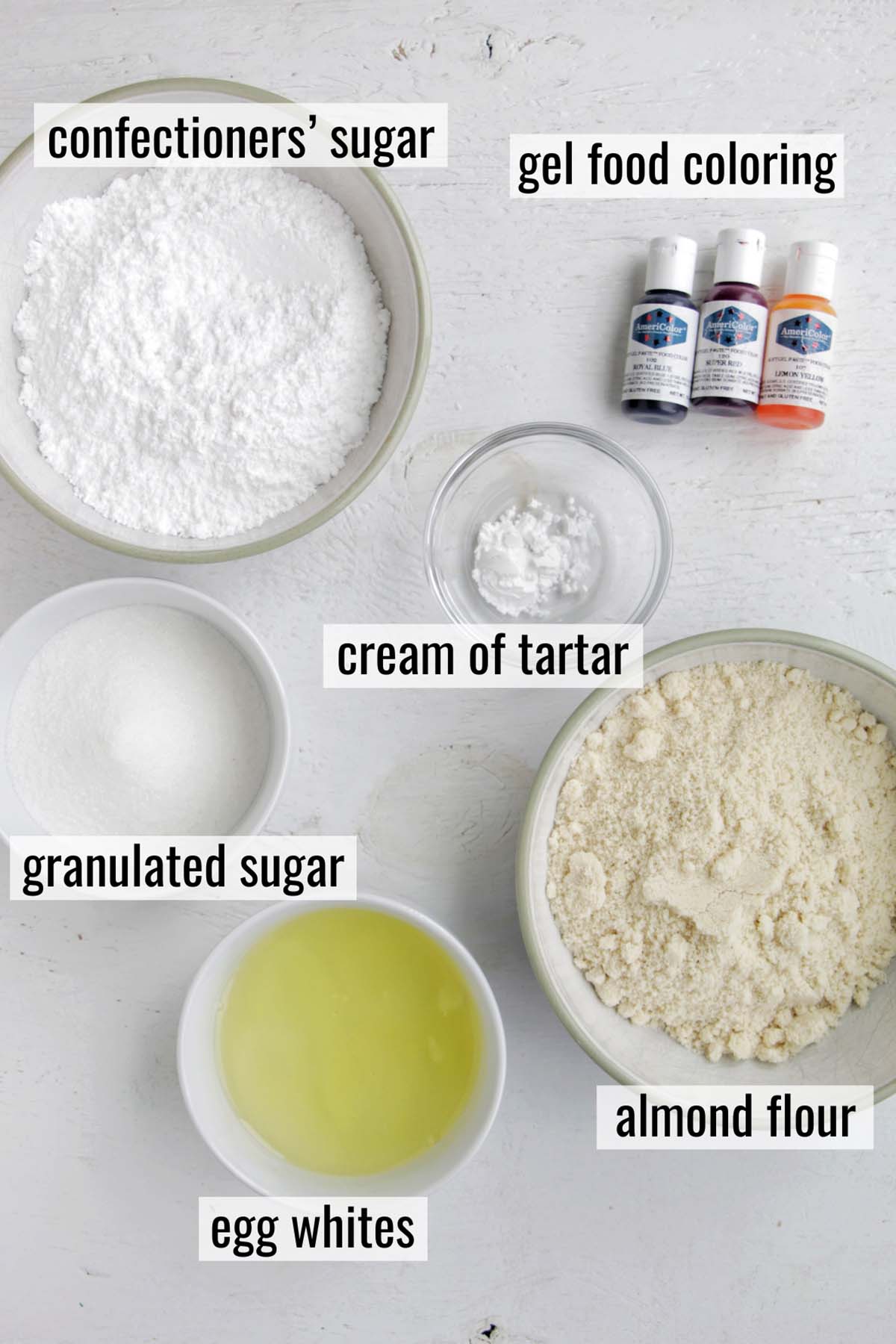
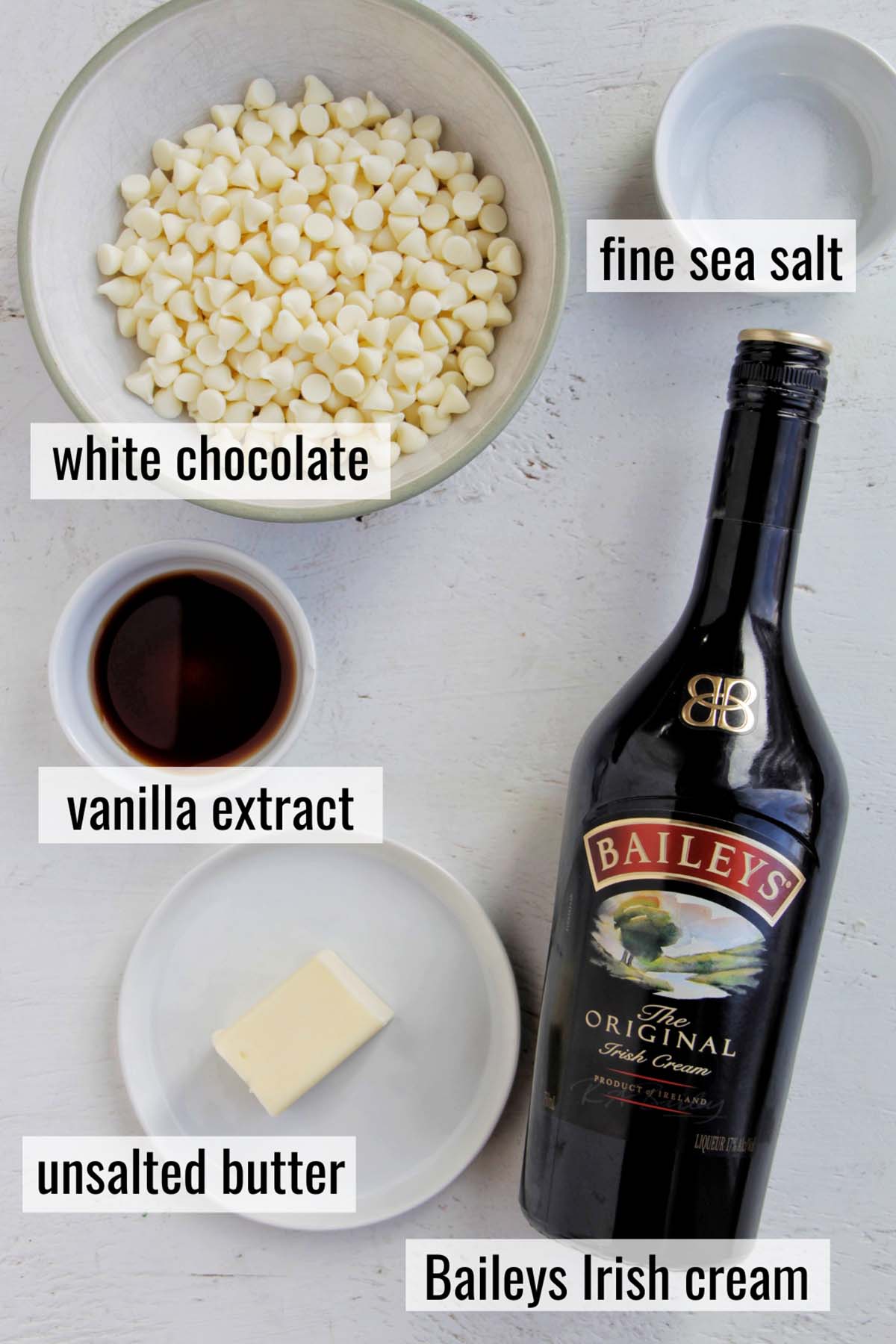
- Egg whites: Egg whites are a very important ingredient in macarons that help provide structure in the macaron shells. Allow the egg whites to come to room temperature before baking.
- Almond flour: This ingredient is made from grinding almonds into a very fine powder. Be sure to sift the almond flour with the confectioner's sugar for bump-free macaron shells.
- Confectioners' sugar: Also called powdered sugar, this ingredient helps to create the correct texture and feet on the macaron shell.
- Cream of tartar: Cream of tartar is an acid that's added to the egg whites at the beginning of the whipping process. This ingredient helps to stabilize the egg white foam as well as prevent an overwhipped meringue.
- Granulated sugar: Granulated sugar is added to the egg whites while helping the meringue build a strong structure.
- Dark green gel food coloring: Be sure to use gel food coloring (not liquid) to get the best color. Plus, liquid food coloring can cause hiccups with the macaron batter.
Check out the recipe card below for a full list of ingredients and measurements.
How To Make This Recipe
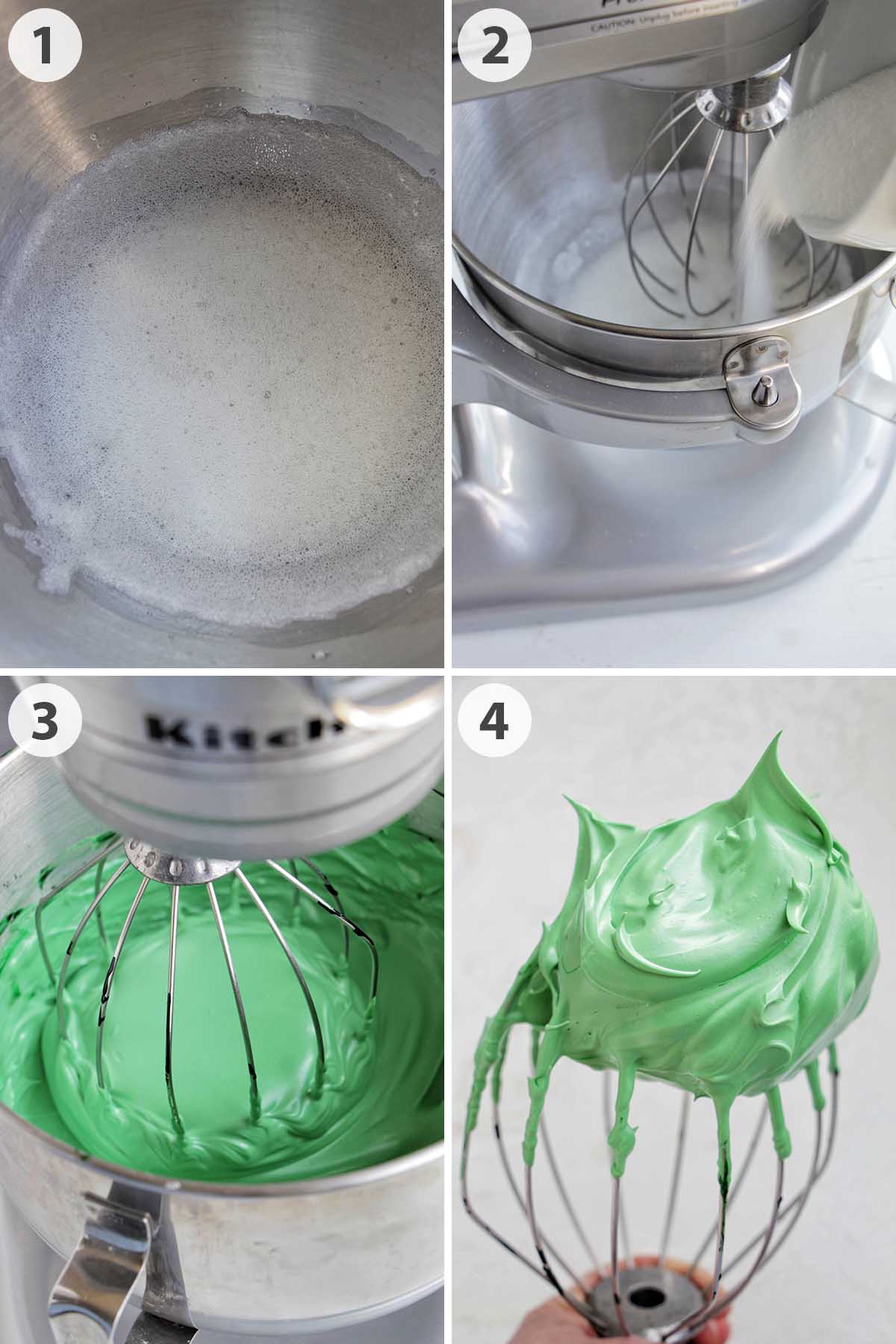
1. Start by doing some prep work to get everything ready for baking macarons. This includes separating the egg whites and yolks, wiping down the mixing bowl with white vinegar, and preparing the baking sheets with two shamrock macaron templates.
Next, add room temperature egg whites and cream of tartar to a stand mixer bowl fitted with a whisk attachment. Whip on medium-low speed until the eggs are very foamy, about 3 minutes.
2. Add a third of the granulated sugar at a time, allowing the mixer to beat in each batch of sugar for about 45 seconds before adding in another batch.
3. Once all the granulated sugar is incorporated, turn the mixer speed to medium-high, and allow the egg whites to continue to whip until stiff peaks form, about 10 - 11 minutes. Add 5 - 10 drops of green gel food coloring once the egg whites reach soft peaks stage.
4. Once at stiff peaks, you'll notice a few visual indicators:
- The meringue starts to ball up inside the whisk while it's mixing.
- Pull the whisk out of the mixer. A stiff peak should stand straight up (no curl at the tip).
- You can see pointy off-shoots of egg whites on the whisk when you pull it out of the mixer.
- You can fully flip the bowl over and nothing moves or falls out.
- The meringue feels sturdy (not flimsy).
- The egg whites hold the indentation that the whisk makes as it's whipping.
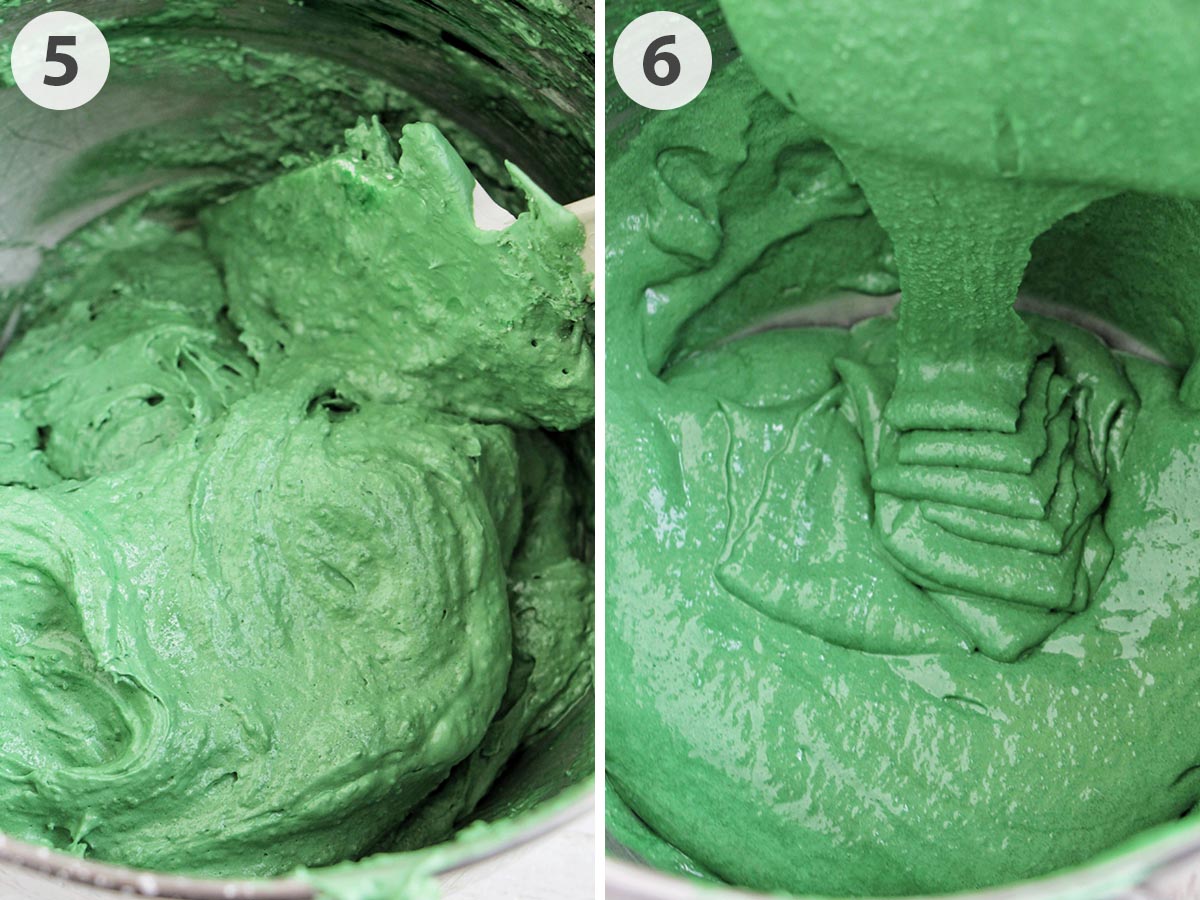
5. Pour the sifted almond flour and confectioners' sugar into the meringue mixture, and gently fold them together using a silicone spatula.
6. Next, it's time to macaronage (mix) the batter so it forms the correct consistency. Slowly and gently spread the mixture along the side of the bowl, then wipe it back down. Repeat until the mixture has reached a smooth, shiny, flowing consistency.
You can test this by lifting your spatula and seeing if the batter drops almost like lava. Once the batter drops back into the bowl, it should take about 10 - 15 seconds for the ribbon that formed to "disappear" back into the rest of the batter.

7. Next we're going to pipe the macaron shells in a clover shape. You can use this free shamrock macaron template to help guide your piping.
8. I like to start by piping one of the clover leaves from outside to inside. You'll see that one leaf is piped almost into the shape of a 'V'.
9. Continue this piping technique with the remaining two leaves.
10. Each template should allow you to pipe nine shamrocks. Repeat this process until you run out of macaron batter.
Then, tap the sheet pan down the counter a few times to release any air bubbles, and pop any large bubbles with a toothpick.

11. Allow the batter to sit on the counter and dry for 60+ minutes until a thin "skin" develops, and you can touch the tops without ruining the macaron. This resting time will vary depending on the humidity (they may take up to 90+ minutes to dry if you live in a humid or rainy environment).
12. Bake one sheet at a time on the center rack of the oven heated at 300°F (150°C) for 19 - 23 minutes. You can test that the macarons are done by gently touching the edge and the feet of the macarons. If the shell wiggles, is sticky, or wet, the macarons need to bake longer.
If this is your first time baking macarons, you may need to test your oven temperature as different ovens can vary slightly when it comes to the best oven temperature for macaron shells.

13. Next it's time to make the Baileys Irish cream ganache. Place white chocolate morsels and butter in a medium-sized heat-safe bowl. Heat Baileys Irish cream in the microwave, and immediately pour it over the chocolate. Allow the mixture to sit, without stirring, for 3 minutes.
14. Add vanilla extract and fine sea salt to the chocolate, and whisk until the mixture is smooth and fully blended. If there are still bits of chocolate or butter after stirring with the Irish cream for 60 - 90 seconds, heat the entire mixture in the microwave on 50 percent power (medium) for an additional 15 - 30 seconds, then stir until the correct consistency forms.
15. Transfer the ganache to a shallow container, and press plastic wrap against the surface of the ganache (to prevent a skin from forming on top). Place the ganache in the fridge, and allow the mixture to cool until it’s firm enough to pipe, about 1 - 2 hours.
16. Match up macaron shells so that they are paired with a similar size/shaped shell. Pipe the Irish cream filling on one side of the macaron shell using a ½ inch (1.3 cm) round piping tip inside a pastry bag. Gently, place the matching shell on top of the filling.
Expert Tips
Here are a few helpful tips for piping shaped macarons.
- Use a small piping tip so you have more control over the macaron batter.
- Pipe slowly and take your time. It can take a bit of practice to get good at piping shaped macarons.
- Use a silicone baking mat instead of parchment paper. The macaron batter tends to move around less on a silicone mat.
- Make sure to build up the macarons thick enough when piping them into the shamrock shape. If the macarons are not thick enough, they will bake too quickly and become crunchy.
Macaron FAQs
Here are a few common causes of flat macarons:
1. The oven is too hot or too cold: If your oven is too low, you'll notice that the macarons won't properly rise. Not only will they be flatter than a normal macaron, but the feet will be short (under 2 millimeters), and the tops will likely be wrinkly or indented.
On the other hand, if your oven is too hot, the shells will be flat because proper feet will not form. The macarons will bake too quickly on the outside, leaving a moist interior that doesn't properly rise.
2. You under whipped the meringue: You didn't whip your meringue to stiff peaks. Under whipped meringue won't be strong enough to properly rise in the oven. It can lead to flat, wrinkled, or weak macaron tops.
3. You over macaronaged your batter: Another common issue that results in flat macarons is over macaronaged batter. Macaronage is a term that refers to folding the dry macaron ingredients (almond flour and confectioners' sugar) into the meringue. This process smooths the mixture and helps the macarons bake with proper structure.
When you over macaronage, you'll notice the batter is very thin and easily falls off the spatula. You'll also notice that the batter spreads really easily when piped. It might even fall out of your piping bag when transferring from one circle to the next on your piping template.
If you're still having trouble, check out my troubleshooting guide for flat macarons.
Store the macarons in an airtight container in the refrigerator for up to 7 days.
Here are a few common causes of cracked macarons:
1. Your oven is too hot: Most likely, cracked macarons are related to oven temperatures that are too hot. To fix this issue, you'll first want to purchase an oven thermometer.
This inexpensive cooking tool will allow you to see if your oven is heating to the temperature you're setting it to. Oftentimes, home ovens are known for heating hotter or colder than you set the temperature to.
2. Your meringue is under or over whipped: Both under-whipped and over-whipped meringue can result in cracked shells. This is because the meringue needs to have the proper structure in order to rise in the oven.
Weak meringue will not be strong enough to withstand the heat of the oven when baked, causing a cracked top. Alternatively, meringue that has been over-whipped won't have enough air incorporated to properly expand in the oven.
3. You didn't rest your macarons long enough: It's important to allow your macarons to rest on the counter until they've formed a skin.
Typically, you'll need to allow the shells to rest for about 45 - 60+ minutes on the counter until a skin has formed on top. If you live in a humid climate, this may take up to 90+ minutes.
4. You have air bubbles in the macarons: Did you put your macarons in the oven without banging them on the counter? Oftentimes, air bubbles are trapped in the macaron batter. Air bubbles occur naturally in the batter during the macaronage and piping process.
In order to avoid cracked macaron shells, you need to release and pop these air bubbles, otherwise, they will burst in the oven and ruin the shells.
If you're still having trouble, check out my troubleshooting guide for cracked macarons.
Here are a few common causes of wrinkled macaron shells:
1. You used too much cocoa powder: Using too much cocoa powder can cause your macarons to bake up wrinkled. Even 10 grams more can have a huge impact on the macaron shells. Be sure to follow the specific measurements listed in the recipe card below.
2. Your oven temperature is too low: To remedy this, you'll first need to purchase an oven thermometer, and place it in the center rack of your oven to double-check the temperature reading before baking the macarons.
Next, you'll need to play around with your temperature settings. I usually recommend heating your oven to 300°F (150°C) and adjusting from there. Pipe a set of 4 - 6 macarons on a baking sheet and test just a few macarons at a time (so you don't ruin a whole batch).
3. You over or under whipped the meringue: One of the most important techniques to learn, especially when making macarons, is how to whip egg whites to stiff peaks.
Egg whites that are under whipped or over whipped can result in wrinkled shells, weak tops, and macarons that will not properly rise.
4. You over macaronaged the batter: Another common issue related to wrinkly macaron shells is over macaronaging.
Macaronage is a term that refers to folding the dry macaron ingredients (almond flour and confectioners' sugar) into the meringue. This process smooths the mixture and helps the macarons bake with proper structure.
To properly macaronage, you should fold the batter until it reaches a lava-like consistency. You can test this by lifting your spatula and seeing if the batter drops almost like lava. Once it drops off the spatula, the batter that was dripped should fade back into the batter within 10 - 15 seconds.
If you're still having trouble, check out my troubleshooting guide for wrinkly macarons.
Here are a few common causes of weak/soft macaron shells:
1. Your meringue is under whipped. French meringue needs to be properly beaten in order to form a strong macaron. Make sure that you're beating the meringue to stiff peaks.
To test the meringue stiffness, pull the whisk out. A stiff peak should stand straight up (no curl at the tip). Signs that you're ready to test the stiffness include seeing lines left from the beaters in your eggs. In addition, the meringue starts to almost ball up inside the whisk attachment. You'll also know it's ready because you can fully flip the bowl over and nothing moves or falls out.
2. The macaron shells are underbaked. If you don't give your macaron shells enough time to bake in the oven, a sturdy outside will never develop. Make sure to check that the macarons are done before pulling them out of the oven. If you touch the shell and it wiggles or is still sticky/wet, you know they need to bake longer.
Chocolate macarons in particular need to be baked for a longer time in the oven compared to regular macarons. If you notice your chocolate macarons are fragile or have speckled tops after they cool, you likely need to bake them longer.
Here are a few common causes of small feet, no feet, or feet that have ruffled/spread too far:
1. Your oven temperature is too high or too low: Work on dialing in your oven temperature. You may have to try a few different oven temperatures in order to find the perfect temperature for your home oven. You can read more about my experiments with oven temperature if you're curious to learn more.
2. You didn't rest the macarons long enough: Typically, you'll need to allow the shells to rest for about 45 - 60+ minutes on the counter until a skin has formed on top. If you live in a humid climate, this may take up to 90+ minutes.
3. You over or under macaronaged the batter: If you've over macaronaged your batter, it will be too thin and runny. This will cause your macarons to fall flat with small feet or even no feet. An overworked batter can also cause the macarons to spread out horizontally, rather than rising up vertically.
If you're still having trouble, check out my troubleshooting guide for macaron feet.
Here are a few common causes of hollow macaron shells:
This is the last troubleshooting problem you should worry about. Before perfecting your macarons so they don't have hollows, make sure all the other properties are correct:
1. The meringue is over and under whipped: In order to prevent hollows, you need the perfect consistency of meringue before starting the macaronage process. Oftentimes, adding in acid, like cream of tartar, can help stabilize your meringue and allow more time for the air to get incorporated.
2. The batter was over or under macaronaged: The macaronage stage, which refers to working your batter to the proper consistency, is a technique that takes a while to master. If you've worked the batter to a lava-like consistency, and you're still getting hollow shells, try working it a tad less.
3. Your oven temperature is too high or low: Oven temperature plays a big role in hollow macarons. Unfortunately, due to the capabilities of home conventional ovens, you have to test and play around with the temperature to get your macaron shells perfect. Most recipes suggest baking macarons anywhere from 275°F (135°C) - 325°F (163°C). Test these temperature ranges out with your home oven and an oven thermometer to see what works best.
If you're still having trouble, check out my troubleshooting guide for hollow macarons.

More Macaron Recipes
Love this recipe? Please leave a 5-star ⭐⭐⭐⭐⭐ rating in the recipe card below. Don't forget to follow along on Instagram, Facebook, YouTube, and Pinterest for more recipes.

St. Patrick's Day Shamrock Macarons
Equipment
- stand mixer with whisk attachment
- light colored baking sheets
- silicone mat or parchment paper
- pastry bag with 0.8 inch (20 mm) round tip
Ingredients
Macarons
- 112 grams egg whites
- 140 grams super fine almond flour
- 140 grams confectioners' sugar
- ½ teaspoon cream of tartar
- 126 grams granulated sugar
- 10 drops dark green gel food coloring
Baileys Irish Cream Ganache
- 1 ¼ cups white chocolate morsels
- 3 tablespoons unsalted butter softened to room temperature and cut into 1 tablespoon (14 grams) pieces
- ⅓ cup Baileys Irish cream
- 1 ½ teaspoons vanilla extract
- ¼ teaspoon fine sea salt
Instructions
For the Macarons
- Separate egg whites from yolks, and allow egg whites to come to room temperature.
- Measure dry ingredients using a kitchen scale. Double-sift the almond flour and confectioners' sugar together in a large mixing bowl.
- Wipe down the mixing bowl and whisk attachment with a little white vinegar on a paper towel to remove any leftover oils.
- Print off two shamrock macaron templates. Place them on a sheet pan underneath a piece of parchment paper or a silicone baking mat.
- Prepare your piping bag with a small 0.8 inch (20 mm) round tip. Push part of the side of the piping bag into the piping tip to ensure nothing leaks out. Set the bag inside a tall glass, and pull the remaining top of the piping bag out over the outside of the glass to make pouring the batter easy and clean.
- Add room temperature egg whites and cream of tartar to a stand mixer bowl fitted with a whisk attachment. Whip on medium-low speed until the eggs are very foamy, about 3 minutes. Add a third of the granulated sugar at a time, allowing the mixer to beat in each batch of sugar for about 45 seconds before adding in another batch.
- Once all the granulated sugar is incorporated, turn the mixer speed to medium-high, and allow the egg whites to continue to whip until stiff peaks form, about 10 - 11 minutes. Add 5 - 10 drops of green gel food coloring once the egg whites reach soft peaks stage. Once at stiff peaks, you'll notice the meringue starts to ball up inside the whisk and is glossy. To test the meringue stiffness, pull the whisk out. A stiff peak should stand straight up (no curl at the tip). You'll also know it's ready because you can fully flip the bowl over and nothing moves or falls out. Make sure not to overbeat the meringue at this stage (this is when the egg whites look dull or curdled).
- Pour the sifted almond flour and confectioners' sugar into the meringue mixture, and gently fold them together using a silicone spatula. Continue until all the meringue is fully incorporated and no dry bits of almond flour remain on the bottom of the bowl.
- Begin working the batter until everything is fully incorporated (this is called the macaronage process). Slowly spread the mixture along the side of the bowl, then wipe it back down. Be sure to do this gently. Repeat until the mixture has reached a smooth, shiny, flowing consistency. You can test this by lifting your spatula and seeing if the batter drops almost like lava. Once the batter drops back into the bowl, it should take about 10 - 15 seconds for the ribbon that formed to "disappear" back into the rest of the batter. Don't over macaronage the batter or the macarons will not properly bake in the oven.
- Pour the batter into the prepared piping bag. Hold the bag vertically, and gently pipe 60 shamrock macaron shells.
- Tap the sheet pan down the counter a few times to release any air bubbles. Pop the air bubbles with a toothpick. Allow the batter to sit on the counter and dry for 60+ minutes until a thin "skin" develops, and you can touch the tops without ruining the macaron. This resting time will vary depending on the humidity (they may take up to 90+ minutes to dry if you live in a humid or rainy environment). While the macarons are drying, heat oven to 300°F (150°C).
- Bake one sheet at a time on the center rack of the oven for 19 - 23 minutes. You can test that the macarons are done by gently touching the edge and the feet of the macarons. If the shell wiggles, is sticky, or wet, the macarons need to bake longer. Remove macarons from the oven, and allow to cool on baking sheet until completely cooled.
For Baileys Irish Cream Ganache
- Place white chocolate morsels and butter in a medium-sized heat-safe bowl.
- Heat Baileys Irish cream in the microwave on 100 percent power (high) for 1 - 2 minutes, until the Irish cream begins to steam and bubble but doesn’t boil over. Immediately, pour the Irish cream over the chocolate. Make sure all of the chocolate is submerged under the Irish cream. Allow the mixture to sit, without stirring, for 3 minutes.
- Add vanilla extract and fine sea salt to the chocolate, and whisk until the mixture is smooth and fully blended. If there are still bits of chocolate or butter after stirring with the Irish cream for 60 - 90 seconds, heat the entire mixture in the microwave on 50 percent power (medium) for an additional 15 - 30 seconds, then stir until the correct consistency forms.
- Transfer ganache to a shallow container, and press plastic wrap against the surface of the ganache (to prevent a skin from forming on top). Place the ganache in the fridge, and allow the mixture to cool until it’s firm enough to pipe, about 1 - 2 hours.
- Match up macaron shells so that they are paired with a similar size/shaped shell. Pipe the filling on one side of the macaron shell using a ½ inch (1.3 cm) round piping tip. Gently, place the matching shell on top of the filling.
- Mature the macarons with the filling in an airtight container in the refrigerator overnight. This will allow the macarons to slightly soften and develop a deeper flavor.
- Store the macarons in an airtight container in the refrigerator for up to 7 days.
Notes
- You'll notice the meringue starts to ball up inside the whisk while it's mixing.
- Pull the whisk out of the mixer. A stiff peak should stand straight up (no curl at the tip).
- You can fully flip the bowl over and nothing moves or falls out.
- The meringue feels sturdy (not flimsy).


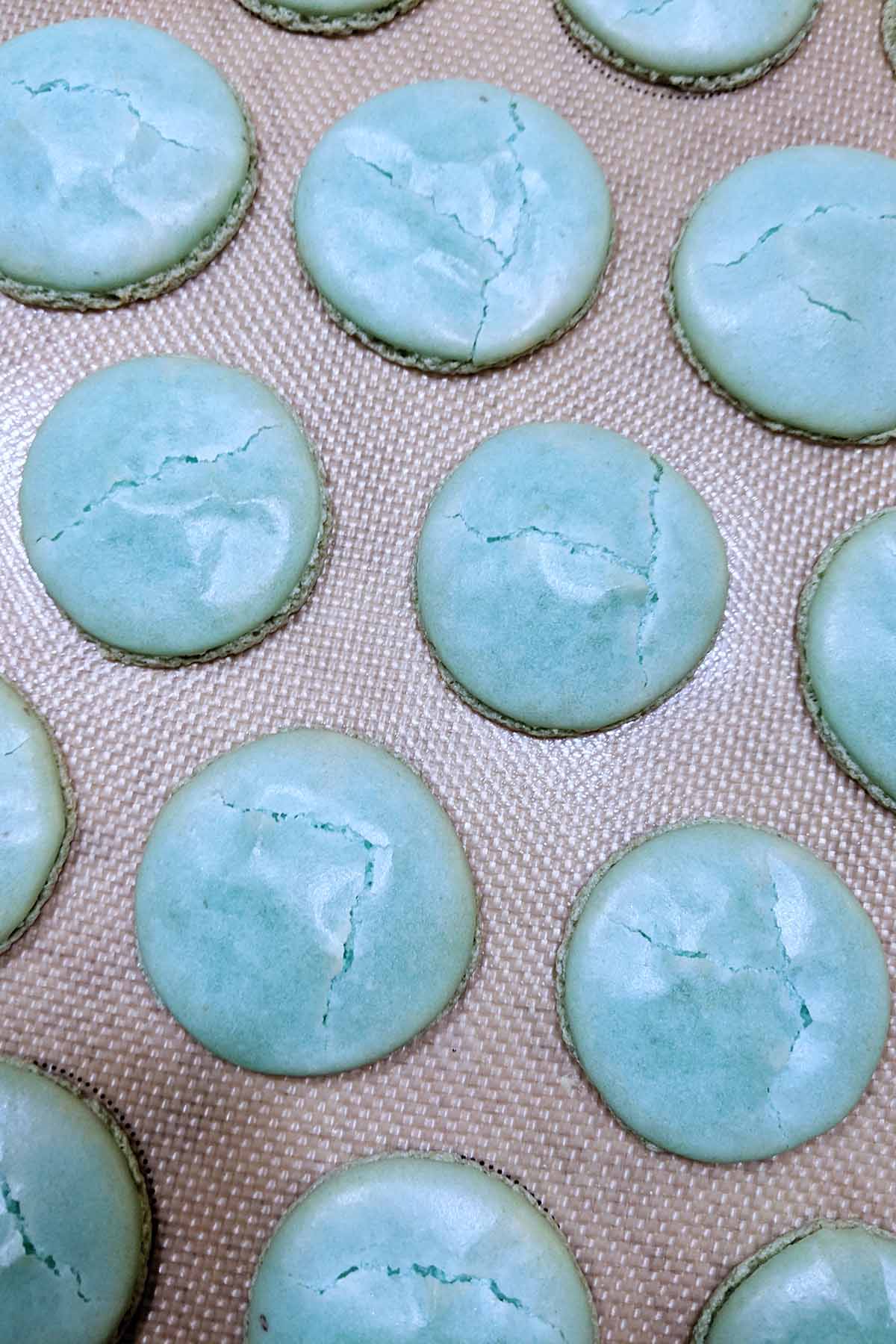
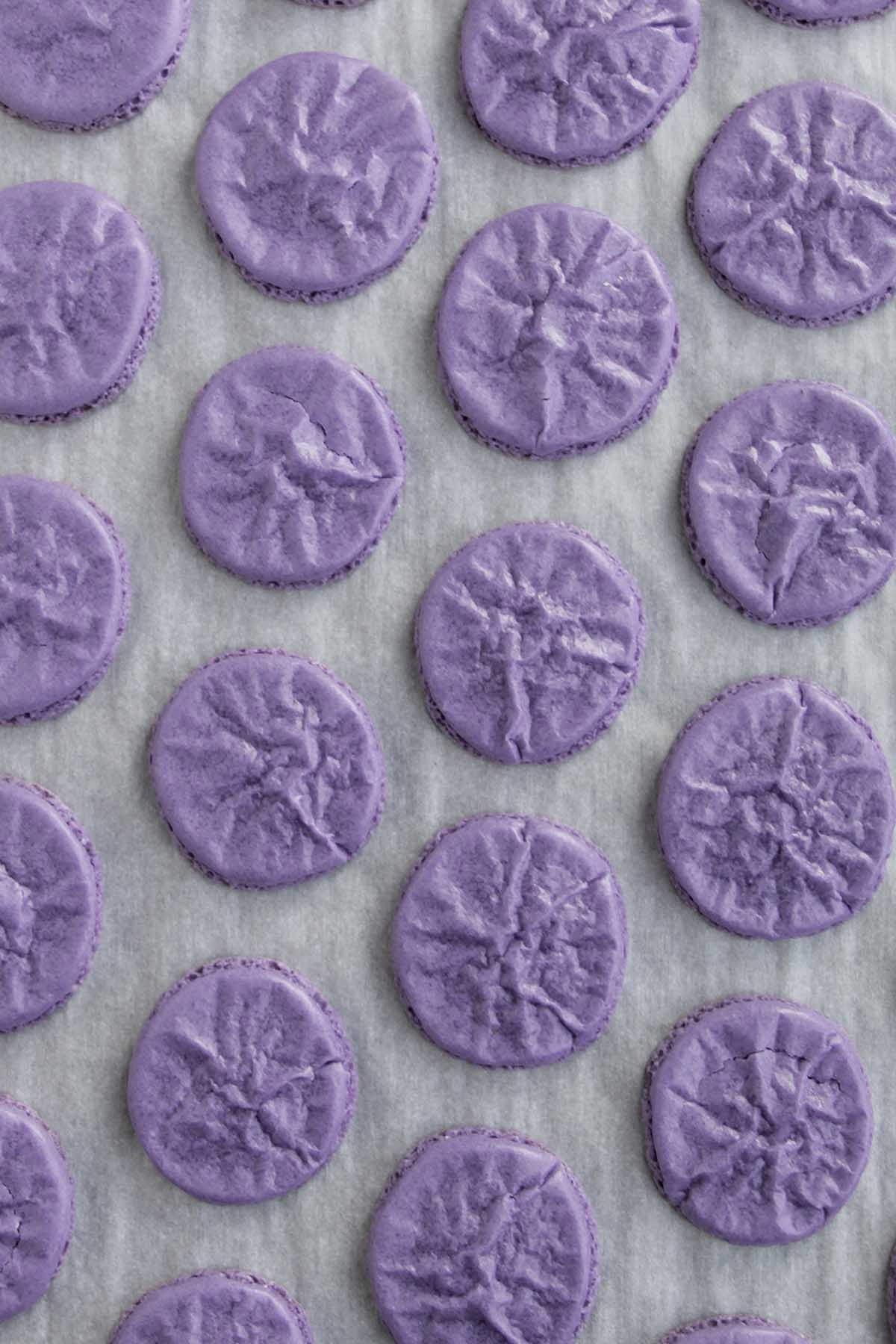
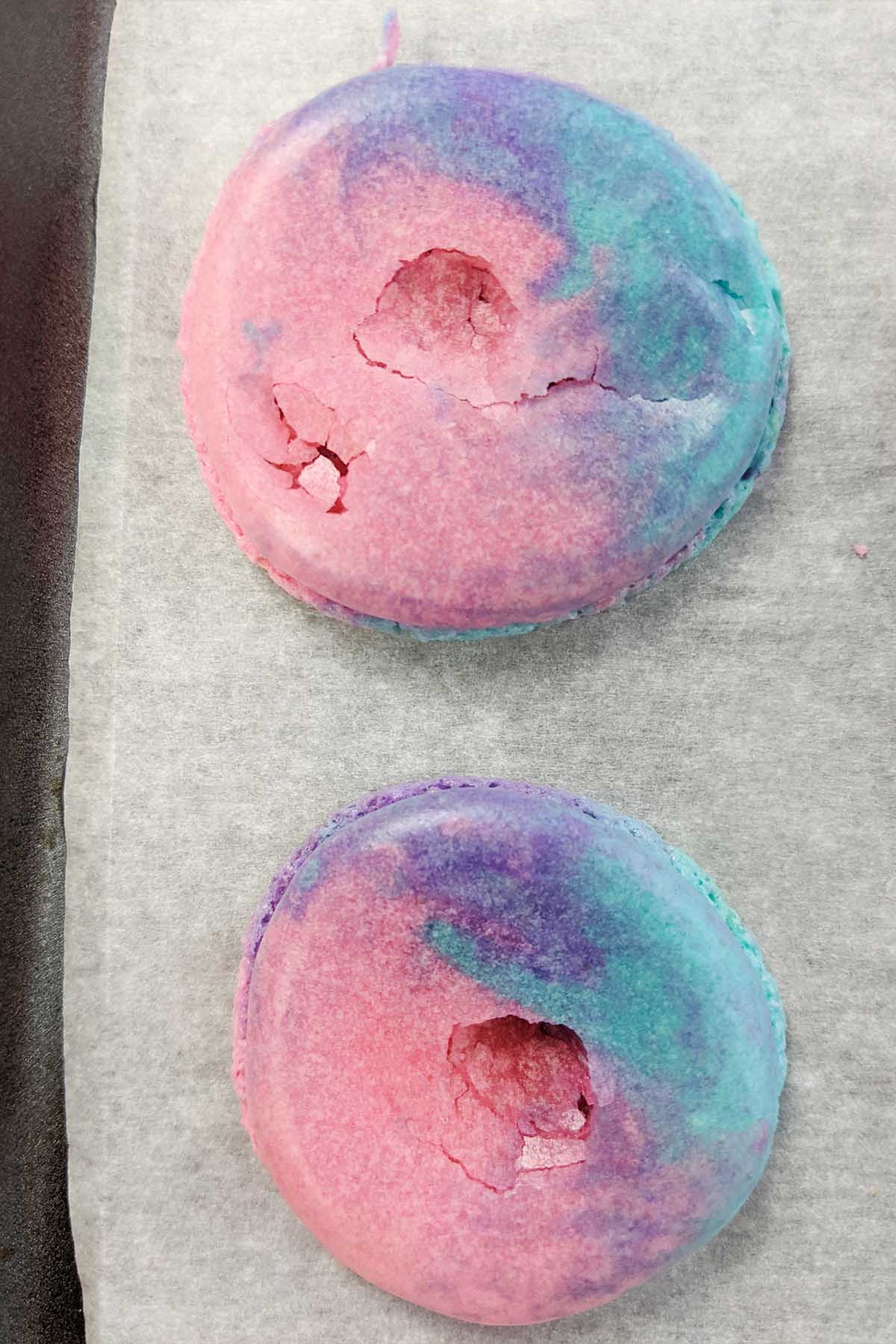
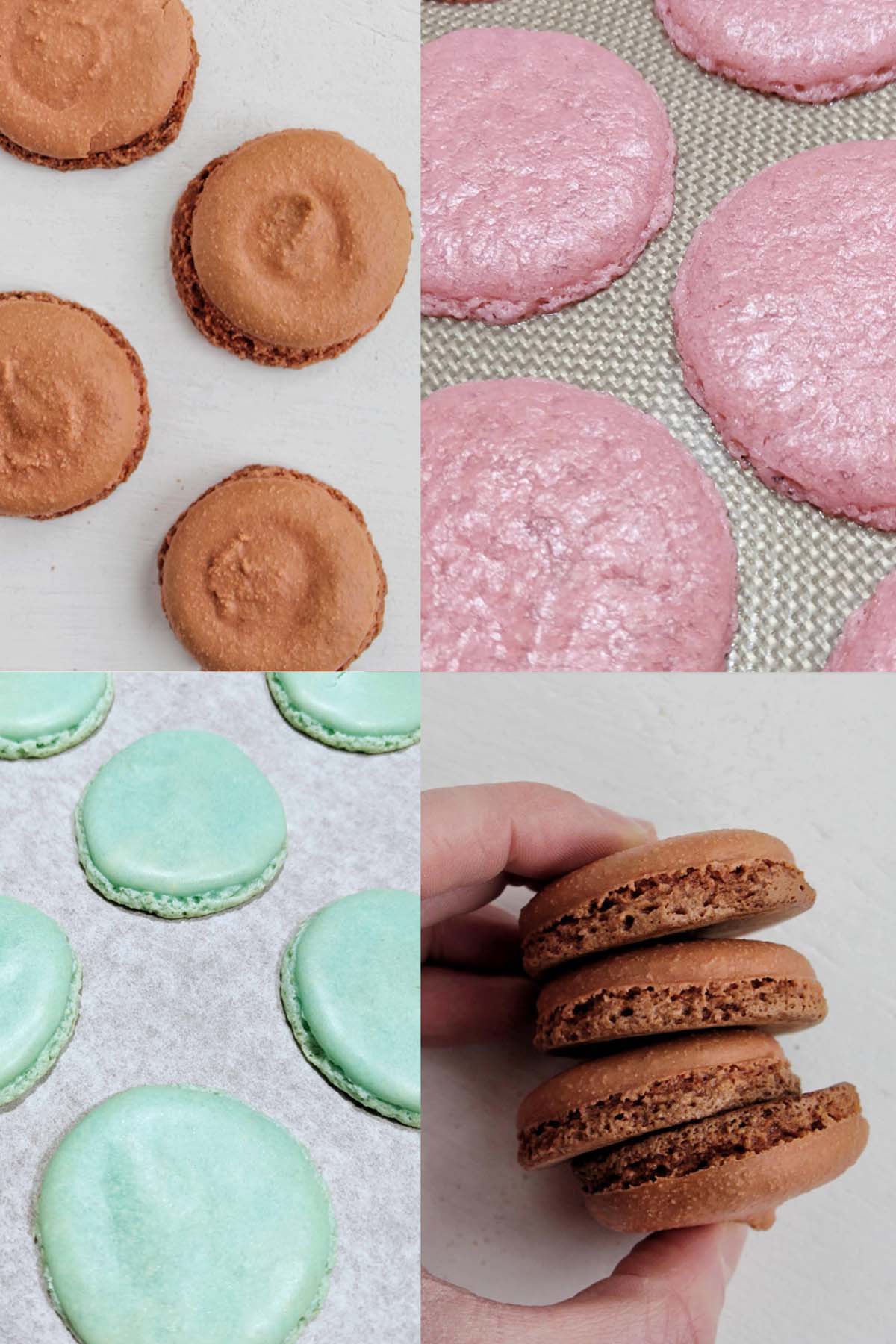


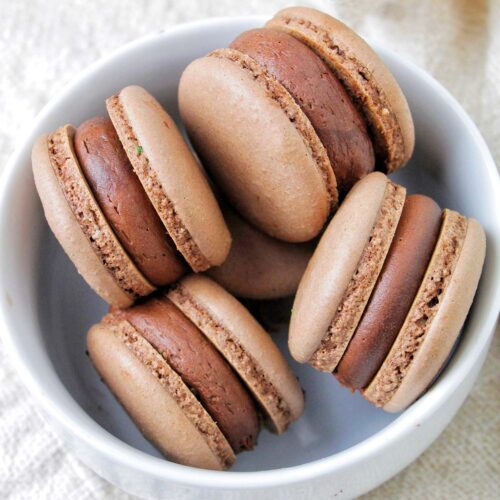
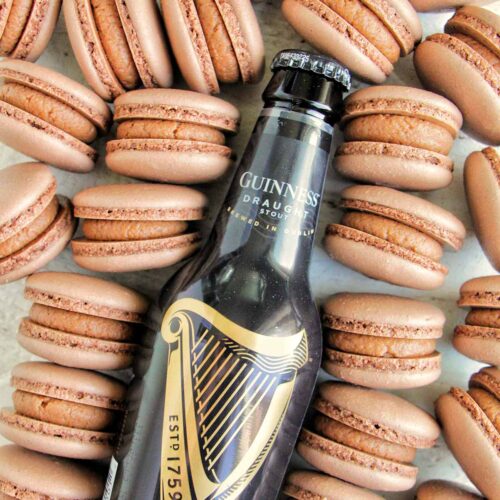
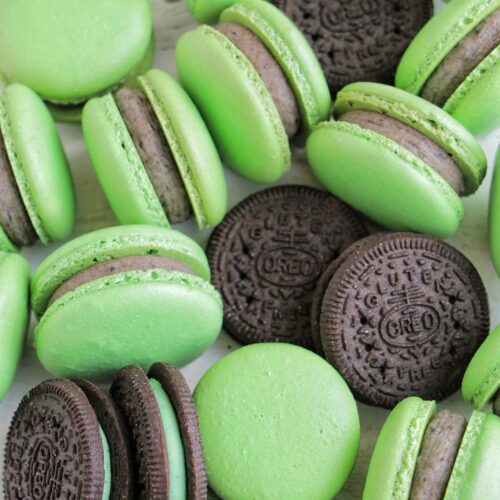
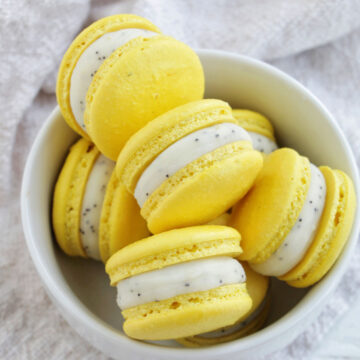
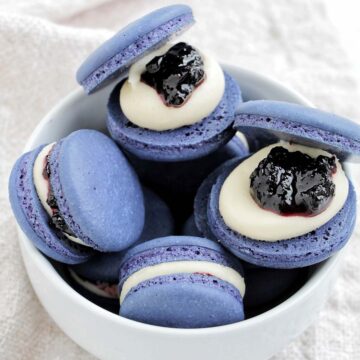



Leave a Reply